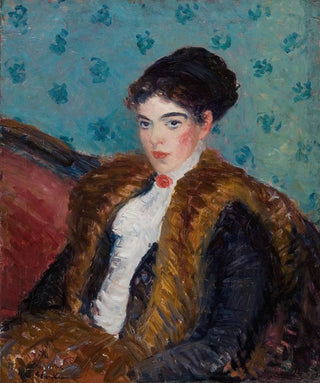Art print | Girl with fox fur - William James Glackens


View from behind

Frame (optional)
In the fascinating world of art, certain works stand out for their ability to capture the essence of their era while evoking deep emotions. "Fille avec des fourrures de renard - William James Glackens" is one of these creations that, through its refined aesthetic, transports us into a world of beauty and sophistication. This painting, depicting an elegant woman draped in furs, embodies not only the opulent lifestyle of the early 20th century but also a reflection on the female condition and identity. By contemplating this piece, the viewer is invited to explore the nuances of fashion, social class, and femininity, while being captivated by the technical virtuosity of the artist.
Style and uniqueness of the work
Glackens' work is distinguished by its impressionist approach, characterized by bold brushstrokes and a vibrant color palette. In "Fille avec des fourrures de renard," the interplay of light and shadow creates an atmosphere that is both intimate and mysterious. The texture of the furs, rendered with remarkable finesse, draws the eye and emphasizes the contrast between the softness of the fabric and the hardness of the outside world. The meticulous details of the woman's face, imbued with a certain melancholy, tell a story that goes beyond appearance. Glackens succeeds in capturing not only the physical beauty of his model but also a psychological depth that invites reflection. This work thus positions itself as a testament to modern art, where form and content intertwine harmoniously.
The artist and his influence
William James Glackens, an emblematic figure of the American Ashcan School movement, knew how to mark his era with his sharp eye on society. Born in 1870, he evolved within a dynamic artistic environment, influenced by European currents while remaining deeply rooted in American reality. Glackens always sought to depict everyday life, but with a particular sensitivity to female subjects. His work "Fille avec des fourrures de renard" perfectly illustrates this concern, highlighting not

Matte finish

View from behind

Frame (optional)
In the fascinating world of art, certain works stand out for their ability to capture the essence of their era while evoking deep emotions. "Fille avec des fourrures de renard - William James Glackens" is one of these creations that, through its refined aesthetic, transports us into a world of beauty and sophistication. This painting, depicting an elegant woman draped in furs, embodies not only the opulent lifestyle of the early 20th century but also a reflection on the female condition and identity. By contemplating this piece, the viewer is invited to explore the nuances of fashion, social class, and femininity, while being captivated by the technical virtuosity of the artist.
Style and uniqueness of the work
Glackens' work is distinguished by its impressionist approach, characterized by bold brushstrokes and a vibrant color palette. In "Fille avec des fourrures de renard," the interplay of light and shadow creates an atmosphere that is both intimate and mysterious. The texture of the furs, rendered with remarkable finesse, draws the eye and emphasizes the contrast between the softness of the fabric and the hardness of the outside world. The meticulous details of the woman's face, imbued with a certain melancholy, tell a story that goes beyond appearance. Glackens succeeds in capturing not only the physical beauty of his model but also a psychological depth that invites reflection. This work thus positions itself as a testament to modern art, where form and content intertwine harmoniously.
The artist and his influence
William James Glackens, an emblematic figure of the American Ashcan School movement, knew how to mark his era with his sharp eye on society. Born in 1870, he evolved within a dynamic artistic environment, influenced by European currents while remaining deeply rooted in American reality. Glackens always sought to depict everyday life, but with a particular sensitivity to female subjects. His work "Fille avec des fourrures de renard" perfectly illustrates this concern, highlighting not






